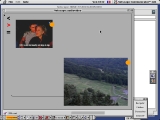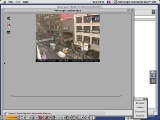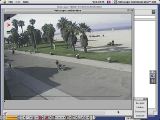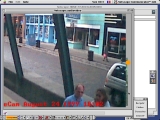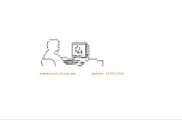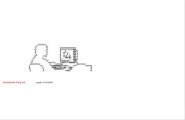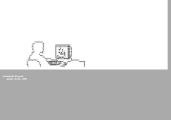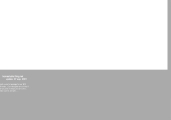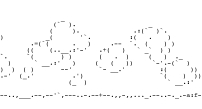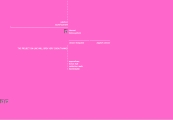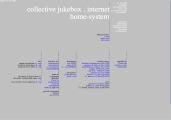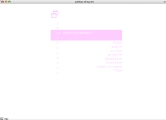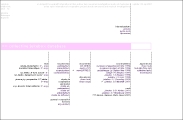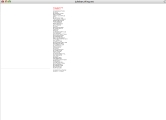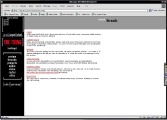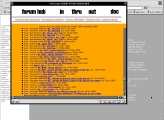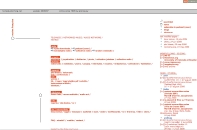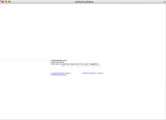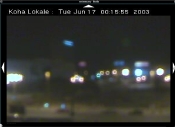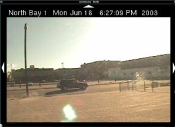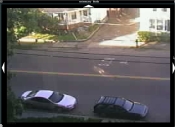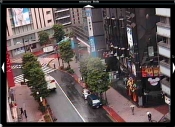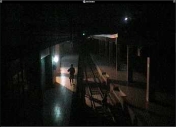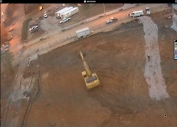← The Thing thing.net documentation |
HOMESTUDIO.THING.NET, JUKEBOX.THING.NET(Edit)
This website is online since 1995. First named "Habitation" and "Metamusique" when it was hosted in France (Imaginet/CIRM/Manca), it became homestudio.thing.net from 1999 to 2007 on The Thing server in NYC. Since August 2007, it's located on nujus.net. Conceived like an extended and on-line studio in order to develop sound and music experimentations on networks, it's also the access place to the various projects I develop around collaborative initiatives and on-line sound systems (Collective JukeBox, Forum Hub, AudioLab, nocinema, and so on).
more about history of The Thing : http://thing.nujus.net/ (not yet available)
Developed by Jerome Joy along these years, a lot of various versions and interfaces have been successively published on the web following the development of the projects. The first html development was on Mosaic and Netscape 1, the first www browsers in the beginning of the nineties. The Homestudio's interfaces have integrated time after time the successive www technologies: html, javascript, embedded media (audio, midi, real, mp3, shockwave, qtvr, and so on), java, dhtml, streamed media, php, etc. Depending on the projects, the developments tried to push, and to simply "forget", the technical constraints in order to avoid to "answer" to these technologies (client, server, bandwidth) but to help the content of the projects. This is because most of the projects had got a long development, adapted time after time, with the "same" intentions, as nocinema.org (former Interludes and AudioVision), Vocales, Collective JukeBox (former Collage Project), and so on.
The links offer to access to the "old" websites or to screen captures. But be careful, these historical and original websites are kept with its own arborescences, so maybe some internal and external links, accesses to some media and pages layouts are no longer available.
Introduction(Edit)
[English version] [French version below]
After the performance work I did in the beginning of the 80’s, followed by works with performed sound recordings, instrumental and electronic composition based on noise sound and sound immersions, I created programmed art on the brink of live composition, distributed sound spatialization and electronic and electroacoustic ambiance. That’s how I came into contact with the Internet in 1995, considering it as an “extension” of the studio, made up of machines (samplers, synthesizers, sequencers, programming software) which are connected to, and interact, with each other; and supplemented by distant relay machines: servers and surfers’ computers.
Using programming languages, I conceived of network musical and sound art pieces; these pieces were original in that they had neither fixed beginning nor ending and in that they had a distributed audience. That’s how I got started working on what I would later call “extended music,” and which I called at the time hyper- or meta-music; music which wove together composition, programming and networks, providing a hint of the possibilities opened up by improvisation and comprovisation; in other words an extended time frame, and in-situ and in-tempo issues, on a much greater scale, and in a manner far different than usual.
These network pieces were unique in that they created “floating” musical states that were all at once combinatory, randomly based on fixed components, and based on complex programs sending out synthetic sound data (and later sound streaming) and simultaneously piloting several servers and the processors of surfers’ machines. Since then, I have come back to performances, working on the network concert and improvisation scene …
In parallel, I developed another project, the Collective JukeBox, between 1996 and 2004, based on suggested (network) listening to a continuously updated body of experimental music and sound pieces; the project brought together more than 1500 pieces of work from over 500 artists. The same goes for the project Lascaux2, one of France’s first e-exhibits, which I produced with Paul Devautour in 1999: an exhibition in an art center closed to the public (the Villa Arson), in which about 15 artists produced art work (continuous installations, performances, etc.) that the public could only experience over the Internet, via a network of webcams.
My work has always had a collective dimension to it… In 1995, I started programming network pieces on a French server (Imaginet), which I left in 1997/98 to actively participate in The Thing server in New York. The originality of that server (and the project conducted by Wofgang Staehle) was that it was both a server for artistic projects, and an artistic collective motivated by similar dynamics and “political” beliefs.
Because the networks were torn between economic and imaginary potentialities, it was important (and it is definitely important today) to think of them as permanent workshops (studios), in other words a multitude of places, regardless of how virtual they may be, made up of synchronous and asynchronous virtual actions, as well as their “exteriors”—the movement, back and forth, between network spaces and physical spaces.
The Thing server, launched in 1991 and closed down in 2007, both for financial and “political” reasons… After it shut down, I started to write a history of The Thing with the help of Wolfgang Staehle, Ricardo Dominguez and Jordan Crandall. The result will be finished in a year or two with (or without) the help of the Ludwig Boltzmann Museum in Linz. I think it’s particularly important today to talk about the “memory” of network projects.
After The Thing, GH Hovagimyan and Peter Sinclair set up the server Nujus.net; it’s the server I’m programming on today, along with the Locus Sonus “research laboratory.”
Introduction(Edit)
[French version]
Après avoir lancé un travail de performance au tout début des années 80, puis de prises de son performées, de composition instrumentale et électronique à partir de sons détournés et bruités et de constructions d’immersions sonores, j’ai développé des œuvres programmées qui oscillent entre composition live, spatialisation sonore répartie et ambiances électroniques et électroacoustiques. C’est ainsi que j’ai pu aborder l’Internet en 1995 en considérant le studio comme un studio « étendu », initialement constitué de machines (samplers, synthétiseurs, séquenceurs, logiciels de programmation) reliées et interactant entre elles, complété par des machines en relais et distantes : les serveurs et les ordinateurs des internautes. En effet, à l’aide des langages de programmation, j’ai pu imaginer le développement d’œuvres musicales et sonores en réseau, avec la particularité d’être sans début ni fin et permanente, et de s’adresser à un auditoire réparti. Cela m’a permis d’aborder ce que j’ai appelé plus tard la « musique étendue », et que je qualifiais à l’époque d’hyper- ou méta-musique entrelaçant composition, programmation et réseaux,,et laissant entrevoir les possibilités liées à l’improvisation et la comprovisation, c’est-à-dire sur des échelles de temps élargies et des questions d’in-situ et d’in-tempo, d’une toute autre manière et ampleur que d’habitude. La particularité de ces œuvres en réseau était d’offrir des états musicaux « flottants », à la fois combinés, aléatoires à partir d’éléments fixés, et basés sur des programmations complexes envoyant des données de synthèse sonore (et plus tard des streamings de sons) pilotant à la fois les serveurs et les processeurs des machines des internautes. À chacun d’écouter à chaque fois des musiques différentes (c’est-à-dire différenciées à partir des mêmes sonorités et structures) selon les fluctuations et les propriétés des réseaux — les débits, les bandes passantes, les paramètres de transmission entrant et agissant dans la programmation et la réception de ces œuvres. À chacun de participer à ces « auditoriums » Internet, à distance, et de construire son écoute momentanément et selon l’acoustique de son lieu de réception. Par la suite et jusqu’à aujourd’hui, en utilisant le streaming, je suis revenu à la performance en étant actif sur la scène des concerts en réseau et de l’improvisation (les duos avec Kaffe Matthews, Emmanuelle Gibello, Julien Ottavi, Eric Leonardson, Pedro Rebelo, etc. ou encore d’autres projets comme celui actuellement avec John Oswald), et à la fabrication d’écoutes collectives à partir d’interfaces d’écoutes partagées (RadioMatic), ce qui m’a permis d’aborder une série d’œuvres combinant le local et le réseau, comme par exemple picNIC avec Formanex/Apo33, ou actuellement Sobralasolas ! avec plusieurs artistes comme Kaffe Matthews, DinahBird, Björn Eriksson, Caroline B et Gregory Whitehead, ou bien encore le projet commencé en 1999, nocinema.org, combinant webcams en direct et structures sonores mixées en temps réel à partir de réservoirs de sons nourris continuellement par une équipe d’artistes (dont Jocelyn Robert, Magali Babin, Chantal Dumas, Christophe Charles, etc.). En parallèle de ces œuvres, j’ai pu développer un autre projet, le Collective JukeBox, entre 1996 et 2004, fondé sur une proposition d’écoute (en réseau) d’un fonds continuellement actualisé d’œuvres musicales et sonores expérimentales, qui a rassemblé plus de 1500 œuvres de plus de 500 artistes. Cela a été aussi le cas du projet Lascaux2, une des premières e-expositions en France, que j’ai réalisé avec Paul Devautour en 1999 : une exposition dans un centre d’art fermé au public (la Villa Arson), dans lequel une quinzaine d’artistes ont réalisé des œuvres (installations continuelles, performances,etc.) durant trois mois, le public ne pouvant suivre les œuvres qu’au travers d’un réseau de webcams accessibles sur Internet. Cet aspect collectif a toujours été présent dans mon travail et s’est révélé d’autant plus proéminent en travaillant sur les réseaux, car en effet, en commençant le développement d’œuvres en réseau vers 1995 sur un serveur français (Imaginet), j’ai ensuite quitté celui-ci en 1997/98 pour participer activement au serveur The Thing à New-York. La particularité de ce serveur (et de ce projet mené par Wolfgang Staehle) était d’être un serveur destiné aux projets artistiques, et à la fois de créer malgré tout un collectif d’artistes mûs par des dynamiques similaires et des positions « politiques ». Les réseaux étant tiraillés entre potentiels économiques et imaginaires, il était important (et il est très certainement encore important) de penser les réseaux comme un « atelier » (un studio) permanent, c’est-à-dire de multiples lieux, aussi virtuels soient-ils, constitués à la fois d’actions à distance, en temps réel ou en différé, et de leurs « extérieurs » — les va-et-vient entre espaces en réseaux et espaces physiques. Le serveur The Thing lancé en 1991 a fermé en 2007, à la fois pour des questions financières — le serveur était autogéré et possédait un financement propre en offrant un service de provider sur New-York —, et pour des questions « politiques » suite à des projets successifs (Etoy, Dominguez, Yesmen, etc.) qui ont été considérés comme trop critiques et subversifs vis-à-vis de multinationales (comme Dow Chemical par exemple). Du jour au lendemain, le serveur a été fermé manu militari et la plupart des serveurs ont été détruits sur place (un seul a survécu sur les sept existant à l’époque). À la suite de cette fermeture, et ne trouvant aucun « miroir » des projets hébergés et une mémoire du projet The Thing, j’ai entrepris d’écrire une histoire de The Thing. Depuis un an, je travaille avec Wolfgang Staehle, Ricardo Dominguez et Jordan Crandall pour à la fois reconstituer cette histoire et d’autre part, remettre à flot les archives du serveur avec l’aide des artistes qui ont participé à cette aventure. Le résultat verra le jour dans un an ou deux, avec l’aide (ou non) du Ludwig Boltzmann Museum à Linz. Il me semble particulièrement intéressant aujourd’hui de parler de « mémoire » pour les projets en réseau. (Jérôme Joy, 2009)
1997/98 | Homestudio (manca imaginet website)(Edit)
http://www.imaginet.fr/manca/joy/
http://www.imaginet.fr/manca/invite/laboratoire/
http://www.imaginet.fr/homestudio/
| Homepage (03/1998)->[archive] | 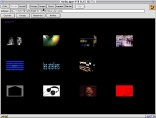 Vocales (1998) Vocales (1998)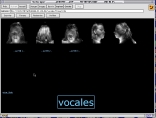 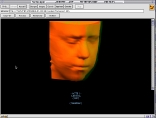 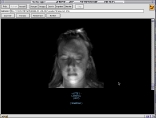 Midiphonics (1998) Midiphonics (1998)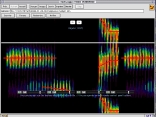 Interludes (1998) Interludes (1998)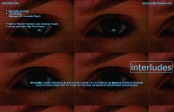 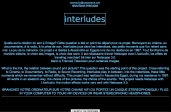 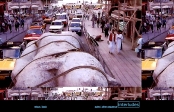 Audiovision (1998) Audiovision (1998) 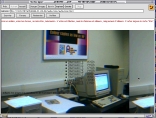 |
| Homepage (09/1998)(screencapture)Homepage (12/1998)->[archive] | 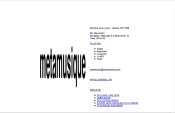 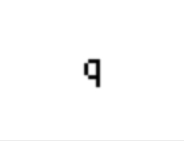 |
1999/2007 | Homestudio (The Thing website)(Edit)
http://homestudio.thing.net/
http://jukebox.thing.net/
Internet Archive: the Wayback Machine(Edit)
http://www.archive.org/
Browse through 85 billion web pages archived from 1996 to a few months ago.
http://archive.bibalex.org, the Internet archive at the New Library of Alexandria, Egypt, mirrors the Wayback Machine.
The Internet Archive is a 501(c)(3) non-profit that was founded to build an Internet library, with the purpose of offering permanent access for researchers, historians, and scholars to historical collections that exist in digital format. Founded in 1996 and located in the Presidio of San Francisco, the Archive has been receiving data donations from Alexa Internet and others. In late 1999, the organization started to grow to include more well-rounded collections. Now the Internet Archive includes texts, audio, moving images, and software as well as archived web pages in our collections.
To access to the archives of homestudio.thing.net website since 2000:
http://web.archive.org/web/*/http://homestudio.thing.net/
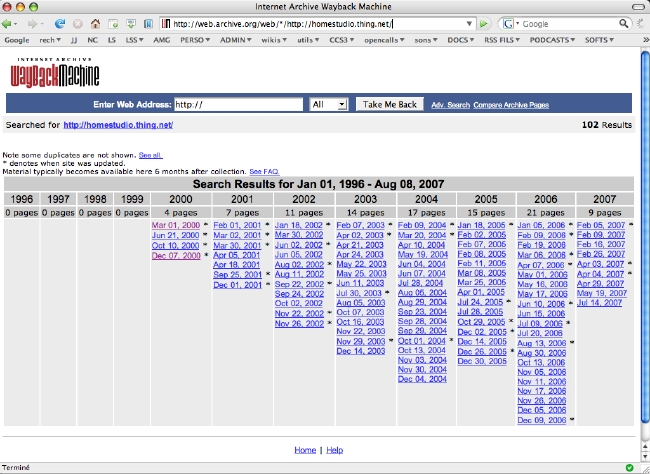
1996/.. | Other on-line projects(Edit)
http://web.azur.fr/artel/
http://web.azur.fr/francialex/
http://www.imaginet.fr/manca/joy/earthsounds/
http://www.lascaux2.org/
http://audiolab.villa-arson.org/
| Artel (1996/97) Villa Arson, a workshop in collaboration with Paul Devautour ->[archive] | 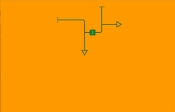 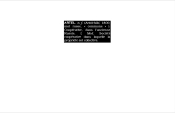 |
| FranciAlex (1998) in collaboration with Senghor University, Alexandria Egypt ->[archive] | 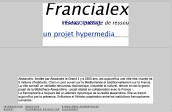 |
| www.491.org (1998/2001) a project by Paul Devautour and Art Schools' teachers and students (screen capture) | 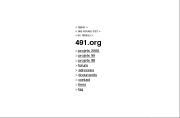 |
| Audiolab (1999) Sound Studio Villa Arson School of Arts ->[archive] |  |
| Earthsounds (1999) a project by Michel Redolfi (CIRM)->[archive] | 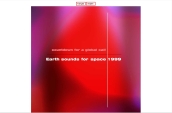 |
| lascaux2.org (1999) Villa Arson Nice, a project with Paul Devautour->[archive] ->[current archive] | 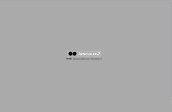 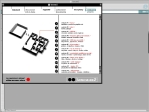 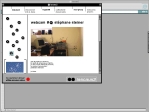  |
| AudioLab (2000/04) Sound Studio Villa Arson School of Arts->[archive]->[on-line archive http://audiolab.villa-arson.org/] | 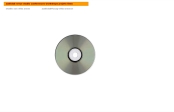 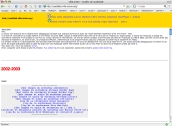 |
